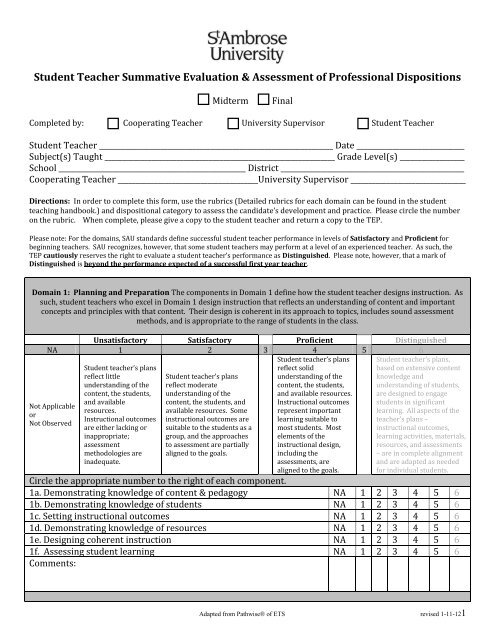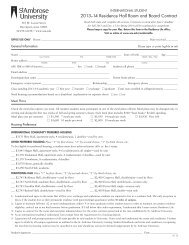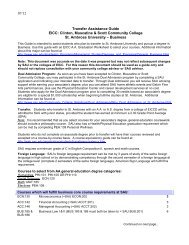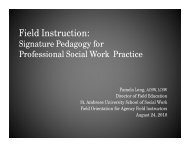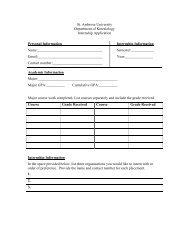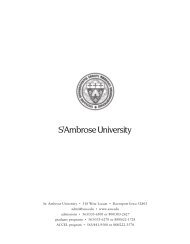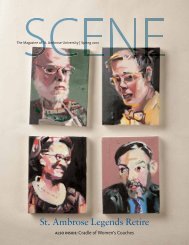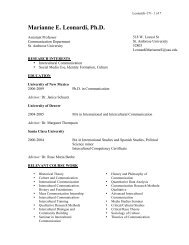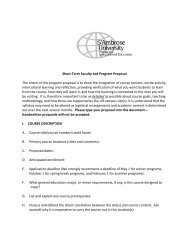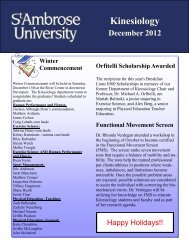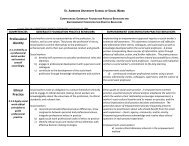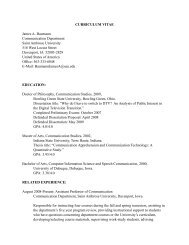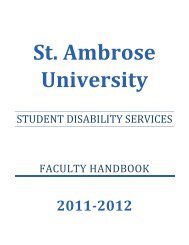Student Teacher Summative Evaluation & Assessment of ...
Student Teacher Summative Evaluation & Assessment of ...
Student Teacher Summative Evaluation & Assessment of ...
You also want an ePaper? Increase the reach of your titles
YUMPU automatically turns print PDFs into web optimized ePapers that Google loves.
<strong>Student</strong> <strong>Teacher</strong> <strong>Summative</strong> <strong>Evaluation</strong> & <strong>Assessment</strong> <strong>of</strong> Pr<strong>of</strong>essional Dispositions<br />
Midterm<br />
Final<br />
Completed by: Cooperating <strong>Teacher</strong> University Supervisor <strong>Student</strong> <strong>Teacher</strong><br />
<strong>Student</strong> <strong>Teacher</strong> _________________________________________________________________ Date ______________________________<br />
Subject(s) Taught ________________________________________________________________ Grade Level(s) __________________<br />
School ____________________________________________________ District ___________________________________________________<br />
Cooperating <strong>Teacher</strong> _______________________________________University Supervisor ________________________________<br />
Directions: In order to complete this form, use the rubrics (Detailed rubrics for each domain can be found in the student<br />
teaching handbook.) and dispositional category to assess the candidate’s development and practice. Please circle the number<br />
on the rubric. When complete, please give a copy to the student teacher and return a copy to the TEP.<br />
Please note: For the domains, SAU standards define successful student teacher performance in levels <strong>of</strong> Satisfactory and Pr<strong>of</strong>icient for<br />
beginning teachers. SAU recognizes, however, that some student teachers may perform at a level <strong>of</strong> an experienced teacher. As such, the<br />
TEP cautiously reserves the right to evaluate a student teacher’s performance as Distinguished. Please note, however, that a mark <strong>of</strong><br />
Distinguished is beyond the performance expected <strong>of</strong> a successful first year teacher.<br />
Domain 1: Planning and Preparation The components in Domain 1 define how the student teacher designs instruction. As<br />
such, student teachers who excel in Domain 1 design instruction that reflects an understanding <strong>of</strong> content and important<br />
concepts and principles with that content. Their design is coherent in its approach to topics, includes sound assessment<br />
methods, and is appropriate to the range <strong>of</strong> students in the class.<br />
Unsatisfactory Satisfactory Pr<strong>of</strong>icient Distinguished<br />
NA 1 2 3 4 5 6<br />
<strong>Student</strong> teacher’s plans <strong>Student</strong> teacher’s plans,<br />
<strong>Student</strong> teacher’s plans<br />
reflect solid<br />
based on extensive content<br />
reflect little<br />
<strong>Student</strong> teacher’s plans<br />
understanding <strong>of</strong> the<br />
knowledge and<br />
understanding <strong>of</strong> the reflect moderate<br />
content, the students,<br />
understanding <strong>of</strong> students,<br />
content, the students, understanding <strong>of</strong> the<br />
and available resources. are designed to engage<br />
and available<br />
content, the students, and Instructional outcomes students in significant<br />
resources.<br />
available resources. Some represent important<br />
learning. All aspects <strong>of</strong> the<br />
Instructional outcomes instructional outcomes are learning suitable to<br />
teacher’s plans –<br />
are either lacking or suitable to the students as a most students. Most<br />
instructional outcomes,<br />
inappropriate;<br />
group, and the approaches elements <strong>of</strong> the<br />
learning activities, materials,<br />
assessment<br />
to assessment are partially instructional design,<br />
resources, and assessments<br />
methodologies are aligned to the goals.<br />
including the<br />
– are in complete alignment<br />
inadequate.<br />
assessments, are<br />
and are adapted as needed<br />
aligned to the goals.<br />
for individual students.<br />
Not Applicable<br />
or<br />
Not Observed<br />
Circle the appropriate number to the right <strong>of</strong> each component.<br />
1a. Demonstrating knowledge <strong>of</strong> content & pedagogy NA 1 2 3 4 5 6<br />
1b. Demonstrating knowledge <strong>of</strong> students NA 1 2 3 4 5 6<br />
1c. Setting instructional outcomes NA 1 2 3 4 5 6<br />
1d. Demonstrating knowledge <strong>of</strong> resources NA 1 2 3 4 5 6<br />
1e. Designing coherent instruction NA 1 2 3 4 5 6<br />
1f. Assessing student learning NA 1 2 3 4 5 6<br />
Comments:<br />
Adapted from Pathwise® <strong>of</strong> ETS revised 1-11-121
Domain 2: Classroom Environment The components <strong>of</strong> Domain 2 consist <strong>of</strong> the interactions that occur in a classroom. As<br />
such, student teachers who excel in Domain 2 consider their students as real people, with interests, concerns, and intellectual<br />
potential. In return, the students regard their teachers as concerned and caring adults and entrust them with their futures.<br />
Unsatisfactory Satisfactory Pr<strong>of</strong>icient Distinguished<br />
NA 1 2 3 4 5 6<br />
Classroom environment<br />
<strong>Student</strong>s themselves make a<br />
Classroom<br />
Classroom environment<br />
functions smoothly, with<br />
substantive contribution to<br />
environment is<br />
functions somewhat<br />
little or no loss <strong>of</strong><br />
the smooth functioning <strong>of</strong> the<br />
characterized by chaos effectively, with modest<br />
instructional time.<br />
classroom, with highly<br />
and conflict, with low expectations for student<br />
Expectations for student<br />
positive personal<br />
expectations for learning and conduct, and learning are high, and<br />
interactions, high<br />
learning, no clear classroom routines and<br />
interactions among<br />
expectations and student<br />
standards <strong>of</strong> student use <strong>of</strong> space that partially individuals are<br />
pride in work, seamless<br />
conduct, poor use <strong>of</strong> support student learning. respectful. Standards<br />
routines, clear standards <strong>of</strong><br />
physical space, and <strong>Student</strong>s and the student for student conduct are<br />
conduct, and a physical<br />
negative interactions teacher rarely treat one<br />
clear, and the physical<br />
environment conducive to<br />
between individuals. another with disrespect.<br />
environment supports<br />
high-level learning.<br />
learning.<br />
Not Applicable<br />
or<br />
Not Observed<br />
Circle the appropriate number to the right <strong>of</strong> each component.<br />
2a. Creating an environment <strong>of</strong> respect and rapport NA 1 2 3 4 5 6<br />
2b. Establishing a culture for learning NA 1 2 3 4 5 6<br />
2c. Managing classroom procedures NA 1 2 3 4 5 6<br />
2d. Managing student behavior NA 1 2 3 4 5 6<br />
2e. Organizing physical space NA 1 2 3 4 5 6<br />
Comments:<br />
Domain 3: Instruction The components <strong>of</strong> Domain 3 consist <strong>of</strong> components that are at the heart <strong>of</strong> teaching – the actual<br />
engagement <strong>of</strong> students in content. As such, student teachers who excel in Domain 3 use their knowledge <strong>of</strong> content and<br />
pedagogy, and their instructional plans, to engage students in learning. Through the presentation <strong>of</strong> content, use <strong>of</strong><br />
questioning and discussion strategies, and methods <strong>of</strong> providing feedback to students, student teachers successfully<br />
implement the plans they created in Domain 1.<br />
Unsatisfactory Satisfactory Pr<strong>of</strong>icient Distinguished<br />
NA 1 2 3 4 5 6<br />
All students are highly<br />
Only some students are<br />
Most students are engaged<br />
Instruction is<br />
engaged in learning and<br />
engaged in learning because in learning as a result <strong>of</strong><br />
characterized by poor<br />
make material<br />
<strong>of</strong> only partially clear<br />
clear communication and<br />
communication, lowlevel<br />
questions, little<br />
success <strong>of</strong> the class<br />
contributions to the<br />
communication, uneven use successful use <strong>of</strong><br />
<strong>of</strong> discussion strategies, and questioning and discussion<br />
student engagement<br />
through their<br />
only some suitable<br />
techniques. Activities and<br />
or participation in<br />
participation in<br />
Not<br />
instructional activities and<br />
assignments are <strong>of</strong> high<br />
discussion, little or no<br />
discussions, active<br />
Applicable or<br />
materials. The student<br />
quality, and student teacher<br />
use <strong>of</strong> assessment in<br />
involvement in learning<br />
Not Observed<br />
teacher displays some use <strong>of</strong> and students make<br />
learning, and rigid<br />
activities, and use <strong>of</strong><br />
assessment in instruction and productive use <strong>of</strong><br />
adherence to an<br />
assessment information<br />
is moderately flexible in<br />
assessment. The student<br />
instructional plan<br />
in their learning. The<br />
adjusting the instructional<br />
teacher demonstrates<br />
despite evidence that<br />
student teacher persists<br />
plan in response to students’ flexibility in contribution to<br />
it should be revised<br />
in the search for<br />
interests and their success in the success <strong>of</strong> the lesson and<br />
and modified.<br />
approaches to meet the<br />
learning.<br />
<strong>of</strong> each student.<br />
needs <strong>of</strong> every student.<br />
(Domain 3 continued on next page.)<br />
(Domain 3 continued)<br />
Adapted from Pathwise® <strong>of</strong> ETS revised 1-11-122
Circle the appropriate number to the right <strong>of</strong> each component.<br />
3a. Communicating with students NA 1 2 3 4 5 6<br />
3b. Using questioning & discussion techniques NA 1 2 3 4 5 6<br />
3c. Engaging students in learning NA 1 2 3 4 5 6<br />
3d. Using assessment in instruction NA 1 2 3 4 5 6<br />
3e. Demonstrating flexibility and responsiveness NA 1 2 3 4 5 6<br />
Comments:<br />
<strong>Assessment</strong> <strong>of</strong> Pr<strong>of</strong>essional Dispositions<br />
Adapted from the Iowa TQE Dispositions Team<br />
Caring: Candidates with this set <strong>of</strong> dispositions value and appreciate all aspects <strong>of</strong> other persons’ well being–<br />
cognitive, emotional, physical and spiritual–thereby enhancing opportunities for learning needs <strong>of</strong> other education<br />
students and in working with pr<strong>of</strong>essionals. The following list comprises many, but not all, <strong>of</strong> the qualities,<br />
tendencies, and/or behaviors which characterize a set <strong>of</strong> caring dispositions:<br />
Empathy: Inclination to identify with, and see things from the perspective <strong>of</strong> others.<br />
Compassion: Sympathy, <strong>of</strong>ten with a desire to help relieve the suffering <strong>of</strong> others.<br />
Rapport: Ability to develop appropriate relationships with peers and other stakeholders.<br />
Respect: Shows appropriate regard for the needs, ideas, and experiences <strong>of</strong> others.<br />
Passion: Demonstrates interest, enthusiasm and optimism for the people, content, and context <strong>of</strong> the<br />
teaching/learning process.<br />
Cultural Competence: appreciates and capitalizes upon diversity; is aware <strong>of</strong> and acts to reduce one’s own biases;<br />
employs culturally sensitive pedagogy.<br />
Comments:<br />
Unsatisfactory Basic Pr<strong>of</strong>icient<br />
NA 1 2 3 4 5<br />
Behavior displayed Behaviors are displayed<br />
is contrary to those inconsistently, but there is<br />
expected for this evidence <strong>of</strong> emerging desired<br />
disposition.<br />
behaviors.<br />
Not Applicable<br />
or Not Observed<br />
Desired behaviors are<br />
consistently displayed, and<br />
inappropriate behaviors do not<br />
exist.<br />
Adapted from Pathwise® <strong>of</strong> ETS revised 1-11-123
Communication: Candidates with this set <strong>of</strong> dispositions are sensitive to and skillful in the various aspects <strong>of</strong><br />
human activity. They have effective interpersonal relationship skills and attitudes that foster collaborative<br />
enterprises useful in enhancing the teaching-learning process. The following list comprises many, but not all, <strong>of</strong> the<br />
qualities, tendencies, and/or behaviors which characterize a set <strong>of</strong> communication dispositions:<br />
Presence: keen with-it-ness and engagement in human interactions and other’s needs.<br />
Responsiveness: Attentive to others’ needs; the ability and inclination to act as best meets the needs, subtle as well as<br />
obvious, <strong>of</strong> others and their circumstances.<br />
Attentiveness: Concentrates on others’ communication; takes others’ communication into account.<br />
Authenticity: Genuineness that fosters and enhances the teaching and learning process while exercising judgment<br />
about personal and pr<strong>of</strong>essional boundaries.<br />
Collaborative: Seeks means to involve & work with others in planning, problem solving and learning.<br />
Voice: Speaks out when the need arises.<br />
Comments:<br />
Unsatisfactory Basic Pr<strong>of</strong>icient<br />
NA 1 2 3 4 5<br />
Behavior displayed Behaviors are displayed<br />
is contrary to those inconsistently, but there is<br />
expected for this evidence <strong>of</strong> emerging desired<br />
disposition.<br />
behaviors.<br />
Not Applicable<br />
or Not Observed<br />
Desired behaviors are<br />
consistently displayed, and<br />
inappropriate behaviors do not<br />
exist.<br />
Creativity: Candidates with this set <strong>of</strong> dispositions display the capacity to envision and craft things in novel and<br />
meaningful ways to meet the needs <strong>of</strong> students. The following list comprises many, but not all, <strong>of</strong> the qualities,<br />
tendencies, and/or behaviors which characterize a set <strong>of</strong> creative dispositions:<br />
Flexibility: adapts, adjusts, and modifies practices to meet the needs <strong>of</strong> students and peers; thinks on one’s feet; is<br />
comfortable with change.<br />
Inventiveness: uses the needs and interests <strong>of</strong> students to approach curricular and strategic decisions; visualizes and<br />
implements novel ideas and practices.<br />
Resourcefulness: utilizes resources in effective ways; adapts practices to unforeseen challenges.<br />
Comments:<br />
Unsatisfactory Basic Pr<strong>of</strong>icient<br />
NA 1 2 3 4 5<br />
Behavior displayed Behaviors are displayed<br />
is contrary to those inconsistently, but there is<br />
expected for this evidence <strong>of</strong> emerging desired<br />
disposition.<br />
behaviors.<br />
Not Applicable<br />
or Not Observed<br />
Desired behaviors are<br />
consistently displayed, and<br />
inappropriate behaviors do not<br />
exist.<br />
Critical Thinking: Candidates with this set <strong>of</strong> dispositions have the ability to examine closely, to critique, and to<br />
Adapted from Pathwise® <strong>of</strong> ETS revised 1-11-124
ask questions. They do not accept the status quo at face value but employ higher level thinking skills to evaluate,<br />
analyze, and synthesize. Self-evaluation and reflection characterize candidates with this set <strong>of</strong> dispositions. The<br />
following list comprises many, but not all, <strong>of</strong> the qualities, tendencies, and/or behaviors which characterize a set <strong>of</strong><br />
critical dispositions:<br />
Reflective: takes time consistently to evaluate effectiveness <strong>of</strong> instruction & behavior in terms <strong>of</strong> the larger goals <strong>of</strong><br />
education; nurtures reflectivity in students and peers; reflects on own growth and accountability.<br />
Initiative: exhibits a willingness to pursue solutions to problems or questions; gathers relevant data and persistently<br />
seeks to improve situations or areas <strong>of</strong> need.<br />
Open-mindedness: exhibits an ability to look at different sides <strong>of</strong> an issue; recognizes the possibility <strong>of</strong> error in one’s<br />
own beliefs and practices; does not display or act upon prejudices against people or ideas.<br />
Efficacy: nurtures high expectations, demonstrates self direction and confidence, and empower students and peers.<br />
Humility: Places the needs <strong>of</strong> the learner and/or learning task above ones own ego; reflects on own growth and<br />
accountability.<br />
Comments:<br />
Unsatisfactory Basic Pr<strong>of</strong>icient<br />
NA 1 2 3 4 5<br />
Behavior displayed Behaviors are displayed<br />
is contrary to those inconsistently, but there is<br />
expected for this evidence <strong>of</strong> emerging desired<br />
disposition.<br />
behaviors.<br />
Not Applicable<br />
or Not Observed<br />
Desired behaviors are<br />
consistently displayed, and<br />
inappropriate behaviors do not<br />
exist.<br />
Pr<strong>of</strong>essional: These are qualities and practices that teacher candidates must exhibit in order to be recommended<br />
for licensure, some <strong>of</strong> which are explicit in the Iowa Code <strong>of</strong> Ethics and Code <strong>of</strong> Responsibilities. Candidates should<br />
display all <strong>of</strong> the following qualities and/or behaviors that characterize this set <strong>of</strong> pr<strong>of</strong>essional requirements:<br />
Pr<strong>of</strong>essionalism: endeavors to meet the standards expected <strong>of</strong> a teacher such as appropriateness <strong>of</strong> dress, grooming,<br />
demeanor, punctuality, tact, discretion, courtesy, etc.<br />
Personal and Pr<strong>of</strong>essional Ethics and Integrity: adheres strongly to high moral principles and ethical standards as<br />
expressed in the Iowa Code; evidences integrity.<br />
Work Ethic/Responsibility: attends to school policy for teacher attendance; completes teaching related tasks in a<br />
thorough and efficient manner.<br />
Confidentiality: complies with federal, state, and school policies relating to confidentiality.<br />
Comments:<br />
Unsatisfactory Basic Pr<strong>of</strong>icient<br />
NA 1 2 3 4 5<br />
Behavior displayed Behaviors are displayed<br />
is contrary to those inconsistently, but there is<br />
expected for this evidence <strong>of</strong> emerging desired<br />
disposition.<br />
behaviors.<br />
Not Applicable<br />
or Not Observed<br />
Desired behaviors are<br />
consistently displayed, and<br />
inappropriate behaviors do not<br />
exist.<br />
Adapted from Pathwise® <strong>of</strong> ETS revised 1-11-125
Area(s) <strong>of</strong> strength:<br />
Area(s) or issue(s) <strong>of</strong> concern:<br />
Task to resolve area(s) or issue(s) <strong>of</strong> concern and deadline:<br />
Signature <strong>of</strong> candidate<br />
Date<br />
Signature <strong>of</strong> individual completing form<br />
Date<br />
Adapted from Pathwise® <strong>of</strong> ETS revised 1-11-126


